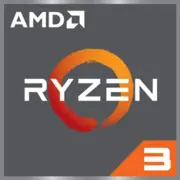AMD Ryzen 3 3200G with Radeon Vega 8 Graphics

AMD Ryzen 3 3200G with Radeon Vega 8 Graphics: A Budget APU for Everyday Tasks
April 2025
1. Key Specifications: Architecture and Key Features
Architecture and Process Technology
The AMD Ryzen 3 3200G is an APU (Accelerated Processing Unit) released in 2019, still relevant for budget builds. It is based on the Zen+ architecture using a 12-nanometer FinFET process technology. This provides a balance between energy efficiency and performance.
Performance
- 4 cores and 4 threads (without SMT support).
- Base frequency — 3.6 GHz, maximum turbo frequency — 4.0 GHz.
- 4 MB of L3 cache — enough for light tasks, but a bit limited for complex multithreaded work.
- TDP 65 W: the processor does not require powerful cooling.
Key Features
- Integrated Radeon Vega 8 Graphics with 8 CUs (512 shader processors) and a frequency of up to 1250 MHz. This is the main advantage for those who do not plan to purchase a discrete graphics card.
- Support for DDR4-2933 MHz: high RAM speed is critical for the performance of the integrated graphics.
Real-World Example: In 2025, the 3200G is often used in office PCs and media centers. For instance, a build with 16 GB DDR4-3200 and SSD provides smooth browsing with 20+ tabs and 4K video playback.
2. Compatible Motherboards
Socket and Chipsets
The processor uses the AM4 socket, which opens up access to a wide range of motherboards:
- Budget chipsets: A320, A520 (suitable for basic builds).
- Mid-range: B450, B550 (support for overclocking and PCIe 4.0 on B550).
- Premium: X470, X570 (redundant for 3200G but compatible).
Selection Recommendations
- For savings, go for A520 boards (price: $60–80). For example, ASUS Prime A520M-K.
- If an upgrade to a more powerful processor (e.g., Ryzen 5 5600) is planned, it's better to choose B550 (price: $90–120) to get PCIe 4.0 support.
Important: Update the BIOS before installation! Some A320/B450 boards require a BIOS update to work with the 3200G.
3. Supported Memory
Types and Speeds
- Only DDR4: the processor does not support DDR5.
- Recommended speed — 2933 MHz (officially), but many boards allow for overclocking up to 3200–3400 MHz.
Configuration
- Use dual-channel mode (2×8 GB instead of 1×16 GB). This increases Vega 8 performance by 20–30%.
- Example: Kingston Fury DDR4-3200 16 GB (2×8) — $50.
Tip: Avoid memory with high latency (CL18+). The optimal latency is CL16.
4. Power Supply Recommendations
Power Calculation
- The processor itself consumes up to 65 W.
- Considering the integrated graphics and other components (SSD, HDD, coolers), a power supply of 400–450 W is sufficient.
- If a discrete graphics card (e.g., GTX 1650) is planned, choose a power supply of 500 W.
Power Supply Examples
- Budget option: EVGA 450 BR (450 W, 80+ Bronze) — $45.
- For upgrades: Corsair CX550M (550 W, semi-modular) — $70.
Important: Do not skimp on the power supply! Cheap models (like $20–30) can fail and damage components.
5. Pros and Cons of AMD Ryzen 3 3200G
Pros
- Price: In 2025, the new processor costs around $80–90.
- Energy efficiency: 65 W TDP + built-in cooler.
- Vega 8 Graphics: can run CS:GO at 60 FPS (1080p, low settings) and GTA V at 30–40 FPS.
Cons
- 4 threads: weak multithreaded performance.
- No PCIe 4.0: a limitation for next-gen SSDs.
- Outdated process technology: 12 nm compared to 7 nm in Ryzen 5000/7000.
6. Use Cases
Office and Multimedia
- Ideal for working with documents, Zoom conferences, and watching 4K videos.
Gaming
- eSports: Dota 2, League of Legends, Overwatch 2 — 60+ FPS on medium settings.
- AAA Games: Cyberpunk 2077 — only at 720p and low settings.
Work Tasks
- Suitable for light video editing (1080p in DaVinci Resolve) and programming.
7. Comparison with Competitors
Intel Core i3-10100 (4/8, UHD 630)
- Pros: Better in single-threaded tasks.
- Cons: UHD 630 graphics are weaker than Vega 8. Price: $100–110.
AMD Ryzen 5 3400G (4/8, Vega 11)
- Pros: Vega 11 is more powerful, has 8 threads.
- Cons: Higher price ($120–130), harder to find new.
Conclusion: The 3200G wins in the budget segment due to its price and graphics.
8. Practical Assembly Tips
- Case: Micro-ATX (e.g., Cooler Master MasterBox Q300L, $50).
- Cooling: The standard cooler is sufficient, but for silence, replace it with DeepCool GAMMAXX 400 ($20).
- Storage: An SSD is essential (Crucial P3 500 GB — $40).
Example Build (2025):
- CPU: Ryzen 3 3200G — $90.
- Motherboard: ASUS Prime A520M-K — $70.
- Memory: Kingston Fury 16 GB DDR4-3200 — $50.
- PSU: EVGA 450 BR — $45.
- Total: ~$255 (excluding case and storage).
9. Final Conclusion: Who Is the Ryzen 3 3200G For?
This processor is worth choosing if:
- Budget is limited ($300–400 for the entire build).
- A PC is needed for office work, study, or media center.
- Light gaming is planned without a discrete graphics card.
Why in 2025?
Despite its age, the 3200G remains a cost-effective option for those who do not need the latest technology. It's easy to find in stores, and compatibility with AM4 allows for future upgrades to Ryzen 5 5600.
Alternative: If the budget allows for an additional $50–70, consider the Ryzen 5 5600G (6/12, Vega 7) — significantly more powerful but more expensive ($150–160).
This article will help you build a reliable PC without overspending. The Ryzen 3 3200G is a time-tested choice for those who value the balance between price and performance.
Basic
CPU Specifications
Memory Specifications
GPU Specifications
Miscellaneous
Share in social media
Or Link To Us
<a href="https://cputronic.com/en/cpu/amd-ryzen-3-3200g-with-radeon-vega-8-graphics" target="_blank">AMD Ryzen 3 3200G with Radeon Vega 8 Graphics</a>